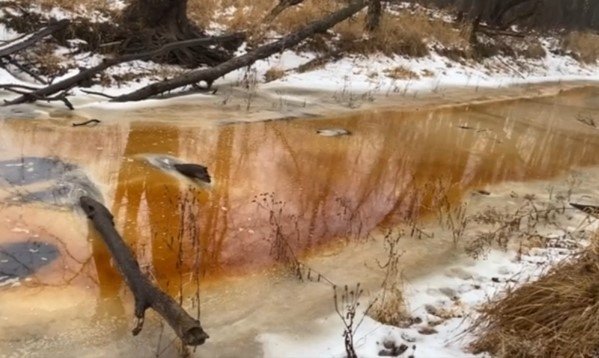How it all began…
In December 2021,
niizh ikwewag gaa-wiiji-bimosewag East Savanna River…
(two women walked along with East Savanna River).
Having long been involved with monitoring Line 3/93’s construction, what they saw shocked them. Mid-winter, large stretches of the river were melted open and a deep orange color clouded the water. They took photos and videos, documenting what they saw, and contacted a friend to discuss what they had seen, what it might mean, and what should be done.
Unbeknownst to those women, less than one month earlier, on November 26-27, 2021, a group of scientists, water protectors, tribal officials, and grassroots organizations had collaborated to commission a fixed-wing high resolution thermal imaging flyover (with an accuracy of 0.3°C in 0.25 meter) of the entire pipeline corridor. As they predicted, this mapping of temperature anomalies in the water and land along the pipeline route revealed places where confined aquifers may have been breached. The time of year, where the land was frozen, clearly revealed every instance of deep underground water (45-50°F year round) upwelling to the surface, with some upwellings arising directly at the pipeline itself. The thermal flyover identified places that pipeline construction appeared to be impacting the surface waters and ecosystems.
At that moment, just after the completion of the pipeline, these various groups, all comprised of people who had been involved in resisting Line 3, were driven by the same call: to bear witness to how Enbridge’s construction had impacted the waters along the pipeline route. Within weeks, individuals from these different projects began to connect and discuss, and a new group – our group – began to meet weekly to piece together a story of what was happening to the water and wetlands all across the state.
In the years since, our group has grown and changed. New people have joined our work and brought passion and focus to the monitoring and interpretation, and helped us tell the story. Some members of our team have gone on to pursue other important work to protect nimaamaa-aki, Mother Earth. As we continue to monitor Enbridge’s construction damages, we are indebted to the inspiration and the care of those first disparate souls. Those individuals and groups, in the dark days at the end of 2021, continued to shine a light on what was happening with Line 3/93.
Since our inception, Waadookawaad Amikwag volunteers have documented dozens of sites of concern. After everything, those first two approaches to monitoring the pipeline — thermal imaging from the sky and ground truthing by field monitors — have remained our best tools for documenting the construction damages. We will continue to do what we can to protect water by documenting the impacts we see and sharing information about what we uncover.
How to say “Waadookawaad Amikwag”
Amik (beaver) is a first responder in an ecosystem when surface water flows have been disrupted. At many of the sites we’ve visited to gather data and bear witness to Enbridge’s water damages, we find that amik has already been there working, building dams to try and control the unnatural flow of water. We call our team Waadookawaad Amikwag or “Those Who Help Beaver,” to affirm our commitment to working with beaver to bear witness to the damages caused by Line 3/93 construction and to trying to prevent further disruptions to water on behalf of all of our human and non-human relatives for future generations.
All that Waadookawaad Amikwag does is rooted in Indigenous Cultural Values…
TEK “The terms ‘Traditional Ecological Knowledge (TEK),’ ‘traditional knowledge,’ and ‘indigenous knowledge’ are often used interchangeably. Defined in many ways, they reflect concepts that have no singular, universal description. Traditional knowledge can be expressed in various ways but most often is transmitted interpersonally by individuals entrusted with its care through languages, stories, songs.”
-Great Lakes Indian Fish & Wildlife Commission


